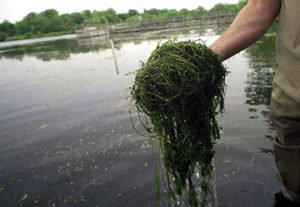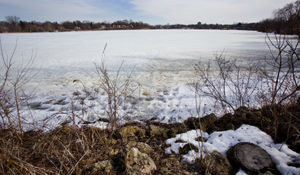 Britta Belden, Water Resource Project Manager (left), and Bob Fossum, Monitoring and Research Division Manager (right), co-led two public information meetings this month to keep the public up-to-date. Capitol Region Watershed District is overseeing the chemical treatment of Como Lake this spring to reduce algae and curly-leaf pondweed, shown at left. (Photo by Margie O’Loughlin)[/caption]
Britta Belden, Water Resource Project Manager (left), and Bob Fossum, Monitoring and Research Division Manager (right), co-led two public information meetings this month to keep the public up-to-date. Capitol Region Watershed District is overseeing the chemical treatment of Como Lake this spring to reduce algae and curly-leaf pondweed, shown at left. (Photo by Margie O’Loughlin)[/caption] By MARGIE O’LOUGHLIN
Como Lake looks relatively clean at this time of year, but a menace to its water quality has had another busy winter.
Curly-leaf pondweed is an invasive aquatic plant visible as a dense surface mat on the lake toward midsummer. It manages to grow vigorously beneath the ice and snow, giving it a huge advantage over native plants in the spring.
Capitol Region Watershed District (CRWD) is the organization working to improve water quality in Como Lake. CRWD believes that the most effective solution for reducing curly-leaf pondweed is to apply the herbicide Fluridone to the entire lake; this was done on April 13. Fluridone will target curly-leaf pondweed, which currently makes up 90% of plant-life in Como Lake.
Britta Belden is a Water Resource Project Manager with CRWD. She said, “The District selected Fluridone for this project because it is safe (no contact restrictions), and is effective at targeting curly-leaf pondweed before native plants start growing. Staff will closely monitor the lake’s response to determine whether future treatments are needed.”
Curly-leaf pondweed usually dies off in late June/July. With the application of Fluridone, die-off will be in April/May. This will prevent curly-leaf pondweed from producing seeds, one of the two ways that it usually spreads.
The treatment will also cause curly-leaf pondweed to die off before it reaches maturity, so there will be much less plant matter decomposing in the water. Decomposing curly-leaf pondweed reduces oxygen levels in the water, and makes phosphorous available for algae to consume. Algae blooms are typical following plant die off, so the less plant matter there is – the better.
Belden continued, “The hope is that eventually only spot treatments will be needed to reduce curly-leaf pondweed, as opposed to whole lake treatments. The surface area of Como Lake is 70 acres. We will never see complete eradication of curly-leaf pondweed, but we can at least get it under control so that native plants can grow.”
Why herbicide?
Bob Fossum is the Monitoring and Research Division Manager with CRWD. He said, “We didn’t want to use an herbicide in the beginning, but we’ve realized through careful study that this is our best option. Curly-leaf pondweed has overrun the ecosystem in Como Lake, making it difficult for native plants and other aquatic species to survive. Herbicide application is the only way we can address an infestation at this level. Mechanical harvesting of this particular invasive species can actually encourage its spread by creating plant fragments.”
The herbicide will be applied at a low concentration of four parts per billion, have no airborne particles, and be safe for humans, pets, birds, and insects. According to Fossum, “Fluridone has a minimal impact of native plants because it is applied so early in the season, before they begin growing.”
Fluridone does not pass from plants to insects to birds, and on up the food chain. The herbicide was applied by a licensed contractor; the application plan was reviewed and approved by the Minnesota DNR.
 Alum treatment in May
Alum treatment in May
Decades of stormwater runoff have resulted in phosphorous levels in Como Lake that are three times higher than the state standard. High phosphorous levels cause algae blooms, which choke oxygen from the lake and kill fish. CRWD and its partners have achieved a 20% reduction in phosphorous from stormwater runoff over the last two decades, but water quality in Como Lake remains poor.
To lower phosphorous levels, alum (aluminum sulfate) will also be applied to Como Lake. Alum is a chemical compound historically used in drinking water, and it is a proven lake management tool. Alum is safe for humans, animals, and aquatic life. It has no known adverse effects.
This treatment involves applying liquid alum beneath the surface of the water from a barge. When liquid alum comes in contact with water, it turns into a fluffy, non-toxic floc, which settles to the bottom of the lake. The floc binds to phosphorous in the water and forms a barrier, making the phosphorous unavailable to algae.
Depending on weather, a whole-lake alum application will take 4-10 days. During application, the Duck Point Parking Lot and Compass Point will be closed. Signage will notify and redirect visitors.
 Visitors will see an immediate change in the water quality and clarity of Como Lake.
Visitors will see an immediate change in the water quality and clarity of Como Lake.
Email questions to Water Resource Project Manager Britta Belden at bbelden@capitolregionwd.org, or call 651.644.8888. Go to www.capitolregionwd.org and follow Capitol Region Watershed District on Twitter, Instagram, and Facebook to learn more about the Como Lake Management Plan.
Comments
No comments on this item Please log in to comment by clicking here